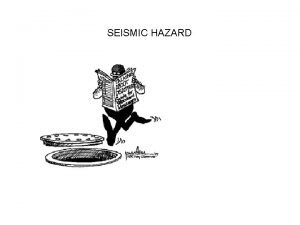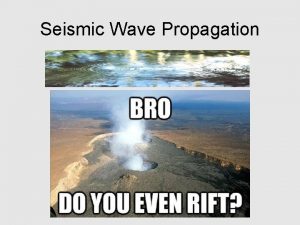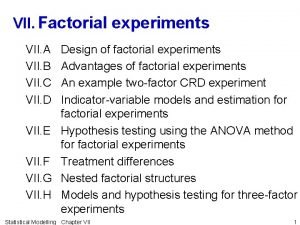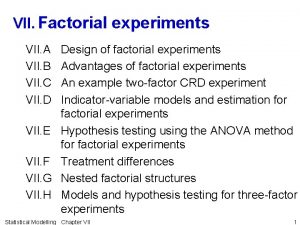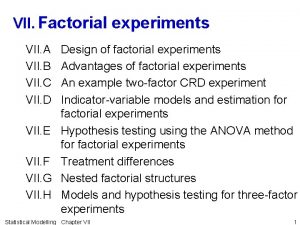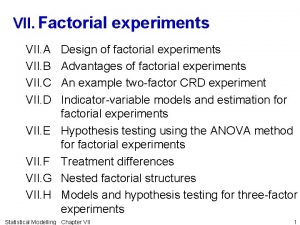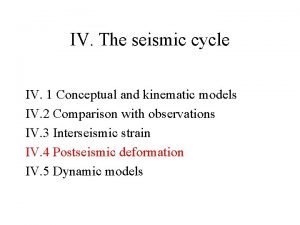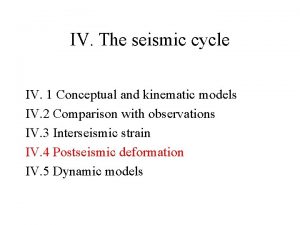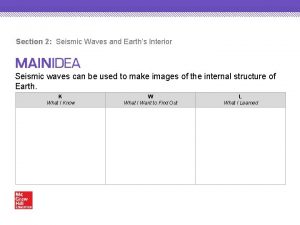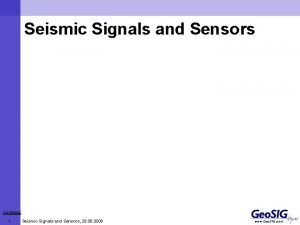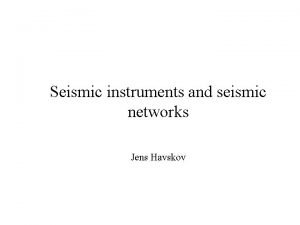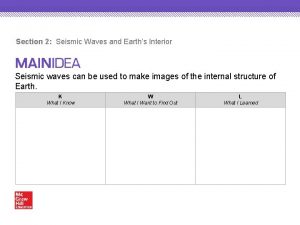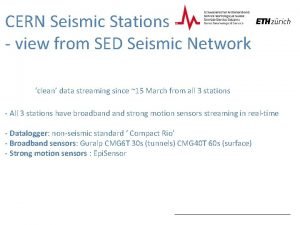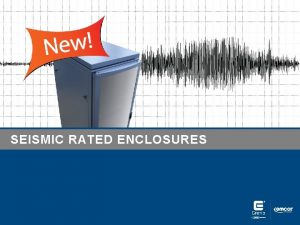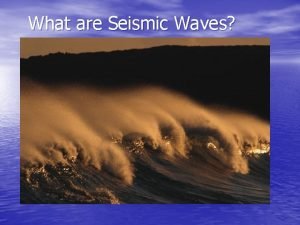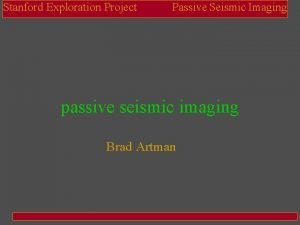VII The seismic cycle VII 1 Conceptual and









































- Slides: 41

VII. The seismic cycle VII. 1 Conceptual and kinematic models VII. 2 Interseimic coupling VII. 3 Comparison with observations

Premises • Slip on any point on a fault results from seismic slip event and/or aseismic creep • Faults are separating domains with negligible deformation in the long term : slip at any point on the fault must be consistent with the rate predicted from the block motion of one side of the fault with respect to the other.

The ‘elastic rebound’ theory = + The medium is purely elastic only if, over a long period of time cumulative coseismic slip near the surface equals slip due to creep at depth. In other words, the fault walls act as rigid blocks that pass each other without internal strain. Long Term = Interseismic + Coseismic

The ‘elastic rebound’ model A testable implication: Long term fault slip rate = average interseismic rate = +

The ‘backslip’ model of interseimsic strain interseismic strain = - Co-seismic strain (except on the fault where the co-seismic strain has a singularity) = + Strain on each side of the fault is equivalent to that obtained from a fault that would slip ‘backward’. This works because by virtue of linear elasticity: -Coseismic (S) = coseismic (-S) (Savage, 1983)

Backslip = - Coseismic = Strain on each side of the fault is equivalent to that obtained from a fault that would slip ‘backward’ (this is because by virtue of linear elasticity: -Coseismic (S)=coseismic (-S) +

Infinite strike-slip fault Interseismic Velocity Interseismic strain rate Co-seismic displacements – Strain rate is constant (velocity field is stationary) if creep rate and locking depths are constant. – Peak strain occurs at the fault: – For x>>h displacements decrease as 1/x and strain decreases as 1/x 2 with distance from the fault.

Infinite Strike-Slip fault = + Interseismic= Long Term - Coseismic with, Interseismic velocity // Oy:

A simplified view of a sequence of earthquakes 1: a fault is embedded in the elastic crust. Peltzer, JPL Lecture, 2003

2 - The fault is locked; plate motion is accommodated by elastic deformation loading shear stress on the fault plane Peltzer, JPL Lecture, 2003

3 - Shear stress reaches failure level and an earthquake occurs, locally releasing stress Peltzer, JPL Lecture, 2003

4 - Stress is redistributed on fault after first event, bringing other section closer to failure and eventually leading to other earthquakes Peltzer, JPL Lecture, 2003

5 - Earthquake sequence goes on… Peltzer, JPL Lecture, 2003

Some events are small and do not break the surface Peltzer, JPL Lecture, 2003

Other are large and produce a surface break Peltzer, JPL Lecture, 2003

In the long run the fault slip uniformly Peltzer, JPL Lecture, 2003

• Are there any Eqs characteristics which can be predicted? – Area of slip events (‘segment’) – Amount of slip in individual event – Timing of slip event



Conceptual Recurrence Models • The characteristic Earthquake Model: A given fault segment always produce the same earthquake (Schwartz and Coppersmith, 1981)

Sometime 1 segment breaks alone, sometimes 2 go together. Slip is similar at the same location

Conceptual Recurence Models • The characteristic Slip Model: At a given point along a fault co-seismic slip is always the same (Sieh, 2000)

(Scholz, 1990)

Conceptual Recurrence Models Slip Stress - Two cases of variable slip models- Time Periodic model - EQs occur when the stress reaches a critical similar value. - All EQs have same stress drop. (Shimazaki and Nakata, 1980) Time-predictable model - EQs occur when the stress reaches a critical similar value. -EQs have various stress drop. If you know the slip on a EQ, you can predict the Time (but not the slip!) of the next EQ Time Slip-predictable model - EQs occur at variable stress states. -EQs have same stress drop. If you know the Time of an EQ, you can predict the Slip (but not the time!) of the next EQ

Earthquakes rupturing repeatedly one location on a fault also tend to cluster in time. (Weldon et al. 2004)

Wrightwood Example • NB: This plot assumes constant interseismic rate (Weldon et al. 2004) Earthquakes are not periodic and seem to be neither time predictable nor slip-predictable.

• Earthquakes are not periodic: – they tend cluster in time and space – returning events rupturing a same fault segments may have different rupture length (but eventually similar slip? )

VII. The seismic cycle VII. 1 Conceptual and kinematic models VII. 2 Interseimic coupling VII. 3 Comparison with observations

Interseismic coupling Implications for Larges. T Ear. Thquakes magnitude and recurrence

before 2005 earthquake after


Interseismic coupling Definition: χi =deficit of slip/long term slip (assigned to a fault, varies in time and space) Determination: Elastic Dislocation Modeling of Interseismic geodetic displacements χi =1 χi =0 Long term slip rate

Interseismic coupling Relation to Seismic slip: If deformation of the hanging wall in the long term is negligible then seismic slip and aseismic transients must balance ISC Implication: The ISC pattern should determine the location, amplitude/frequency of seismic and aseismic transients. χi =1 χi =0 Long term slip rate

Long Term Subduction rate: V

Long Term Subduction rate: V

• Scalar Moment of ‘characteristic’ EQ: • Deficit of Moment rate accumulation Long Term Subduction rate: V (G: Shear Modulus)

Slope: -3/2 Moment Magnitude: Long Term Subduction rate: V

b=0. 94 (Sumatra Megathrust, 1976 -2014) EQs follow the Gutenberg-Richter law with b≈ 1

Frequency of largest EQ in the GR distribution

VII. The seismic cycle VII. 1 Conceptual and kinematic models VII. 2 Comparison with observations

References Bouchon, M. Campillo, and F. Cotton, Stress field associated with the rupture of the 1992 Landers, California, earthquake and its implications concerning the fault strength at the onset of the earthquake, Journal of Geophysical Research. Solid Earth, 103, 21091 -21097, 1998. Cattin, R. , and J. P. Avouac, Modeling mountain building and the seismic cycle in the Himalaya of Nepal, Journal of Geophysical Research-Solid Earth, 105, 13389 -13407, 2000. Marone, C. , Laboratory-derived friction laws and their application to seismic faulting, Annual Review of Earth and Planetary Sciences, 26, 643 -696, 1998. Perfettini, H. , and J. P. Avouac, Stress transfer and strain rate variations during the seismic cycle, Journal of Geophysical Research-Solid Earth, 109, 2004. Schwartz, D. P. , and Coppersmith, K. J. , Fault behavior and characteristic earthquakes: examples from the Wasatch and San Andreas fault zones: J. Geophys. Res. , v. 89, p. 5681 -5698, 1984. Sieh, K. , The repetition of large earthquake ruptures: Hokudan International Symposium and School on Active, p. 465 -468, 2000. Shimazaki, K. , and T. Nakata, Time-predictable recurrence model for large earthquakes, Geophys. Res. Lett. , 7, 279 -282, 1980. Scholz, C. , The Mechanics of Earthquakes and Faulting: New York, Cambridge University Press, 439 p, 1990. Weldon, R. , T. Fumal, and G. Biasi, Wrightwood and the earthquake cycle: What a long recurrence record tells us about how faults works, GSA Today, 14, 4 -10, 2004.
 The teacher and the profession article iv
The teacher and the profession article iv Hình ảnh bộ gõ cơ thể búng tay
Hình ảnh bộ gõ cơ thể búng tay Bổ thể
Bổ thể Tỉ lệ cơ thể trẻ em
Tỉ lệ cơ thể trẻ em Gấu đi như thế nào
Gấu đi như thế nào Tư thế worm breton là gì
Tư thế worm breton là gì Hát lên người ơi
Hát lên người ơi Các môn thể thao bắt đầu bằng tiếng nhảy
Các môn thể thao bắt đầu bằng tiếng nhảy Thế nào là hệ số cao nhất
Thế nào là hệ số cao nhất Các châu lục và đại dương trên thế giới
Các châu lục và đại dương trên thế giới Công của trọng lực
Công của trọng lực Trời xanh đây là của chúng ta thể thơ
Trời xanh đây là của chúng ta thể thơ Mật thư anh em như thể tay chân
Mật thư anh em như thể tay chân 101012 bằng
101012 bằng Phản ứng thế ankan
Phản ứng thế ankan Các châu lục và đại dương trên thế giới
Các châu lục và đại dương trên thế giới Thể thơ truyền thống
Thể thơ truyền thống Quá trình desamine hóa có thể tạo ra
Quá trình desamine hóa có thể tạo ra Một số thể thơ truyền thống
Một số thể thơ truyền thống Bàn tay mà dây bẩn
Bàn tay mà dây bẩn Vẽ hình chiếu vuông góc của vật thể sau
Vẽ hình chiếu vuông góc của vật thể sau Thế nào là sự mỏi cơ
Thế nào là sự mỏi cơ đặc điểm cơ thể của người tối cổ
đặc điểm cơ thể của người tối cổ Ví dụ về giọng cùng tên
Ví dụ về giọng cùng tên Vẽ hình chiếu đứng bằng cạnh của vật thể
Vẽ hình chiếu đứng bằng cạnh của vật thể Vẽ hình chiếu vuông góc của vật thể sau
Vẽ hình chiếu vuông góc của vật thể sau Thẻ vin
Thẻ vin đại từ thay thế
đại từ thay thế điện thế nghỉ
điện thế nghỉ Tư thế ngồi viết
Tư thế ngồi viết Diễn thế sinh thái là
Diễn thế sinh thái là Các loại đột biến cấu trúc nhiễm sắc thể
Các loại đột biến cấu trúc nhiễm sắc thể Số nguyên tố là gì
Số nguyên tố là gì Tư thế ngồi viết
Tư thế ngồi viết Lời thề hippocrates
Lời thề hippocrates Thiếu nhi thế giới liên hoan
Thiếu nhi thế giới liên hoan ưu thế lai là gì
ưu thế lai là gì Hổ sinh sản vào mùa nào
Hổ sinh sản vào mùa nào Khi nào hổ mẹ dạy hổ con săn mồi
Khi nào hổ mẹ dạy hổ con săn mồi Hệ hô hấp
Hệ hô hấp Từ ngữ thể hiện lòng nhân hậu
Từ ngữ thể hiện lòng nhân hậu









































